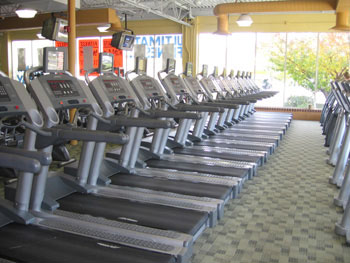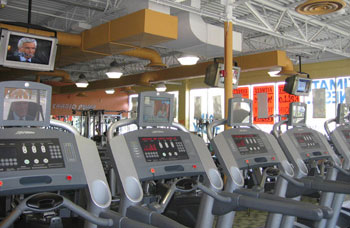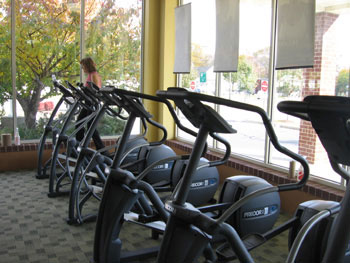|
The Insider Secrets of Interval Training - Learn How Now!
 Without question, High Intensity Interval Training is one of the most effective means available for rapidly losing bodyfat and improving your cardiovascular conditioning. Not only do you burn many more calories while you're performing the training, you also stimulate your metabolism to a far greater degree than with lower intensity training, which is traditionally hailed for fat loss.
Without question, High Intensity Interval Training is one of the most effective means available for rapidly losing bodyfat and improving your cardiovascular conditioning. Not only do you burn many more calories while you're performing the training, you also stimulate your metabolism to a far greater degree than with lower intensity training, which is traditionally hailed for fat loss.
You're going to learn exactly how to perform various types of high intensity interval training to maximize your results. For a full discussion of the advantages of high intensity training over low intensity training, read the following article, which explains it detail:
What Do You Mean Low-Intensity Training Isn't The Best For Fat Burning?
Even though it's more challenging than low intensity training, High Intensity Interval Training offers tremendous benefits to you:
1. It burns more calories than low intensity training, meaning you can burn more fat in shorter workouts.
2. Higher intensities stimulate your metabolism far more AFTER the workouts than lower intensity training. This means you continue to burn calories and fat for long periods after you're done training. Not so with low intensity training.
3. Training at higher speeds, such as with high intensity training can dramatically improve sports performance. Football players can sprint faster and recover more quickly between plays. Tennis players can keep chasing down balls during longer points. Even endurance athletes can benefit by teaching their bodies to work at a faster pace!
In general, interval training is best done 2 or 3 times per week. It is a challenging form of cardio and requires recovery time in between sessions. Interval sessions can last anywhere between 5 to 30 minutes or more, depending on the fitness level of the trainer and the style of intervals being done.
How To Do It:
 Interval training is based on a very simple concept: go fast then go slow. Repeat. It sounds easy, but within this simple formula lies a tremendous number of possible variations and strategies you can employ to take full advantage of the power available to you.
Interval training is based on a very simple concept: go fast then go slow. Repeat. It sounds easy, but within this simple formula lies a tremendous number of possible variations and strategies you can employ to take full advantage of the power available to you.
Interval training can be performed on almost any cardiovascular machine (including the treadmill, stair machine, stationary bike, elliptical trainer, etc.) as well as almost any type of cardiovascular exercise (such as cycling, swimming, running, etc.).
Though the examples I will go through below use time as a measure for intervals, you can also very easily use distance as your guide. For example, you can sprint between two telephone poles then walk to the next one. You can sprint the length of a football field then walk the width. You can even run up a flight of stairs then walk back down. The variations you can do are truly endless!
Here are a number of different types of interval training you can use:
1. Aerobic Interval Training
Aerobic Interval Training is very beneficial for rapidly improving your aerobic conditioning as well as burning fat. It will even help you build up your endurance faster than long-duration cardio! It is also a very good introductory format for starting interval training. If you are new to interval training, I highly recommend beginning with Aerobic Intervals.
This type of interval training involves relatively long work periods and shorter rest periods. Work periods are generally 2 to 5 minutes long in this type of training. The idea is not to take it easy for that work time but to work at a speed that challenges you to be able to make it to the end of that work interval. Your 2 minute interval pace is, therefore, going to be significantly faster than your 5 minute interval pace.
The rest interval for this type of training is between 30 seconds to a minute. Naturally, the shorter the rest period, the tougher the training will be. Too much rest will allow your body to recover too much, lessening the overall training effect of the exercise.
Here are some examples of a number of different intervals you can use in your training:
 Work Rest
Work Rest
2 min. 30 sec.
5 min. 1 min.
3 min. 45 sec.
2 min. 1 min.
5 min. 30 sec.
When using these intervals, you can choose to stick to the same time intervals (e.g. do 2 minutes hard and 30 seconds slow for the duration of the workout) or mix it up with different time intervals as you go through your session. This type of training can generally be done for about 20 to 30 minutes.
2. Maximal High-Intensity Intervals
This type of interval training is VERY high intensity and is VERY effective for fat loss and cardio training. You essentially push yourself to the maximum on every single work interval you do! This type of training is extremely effective when training for sports that require all-out repeated efforts, such as football, soccer, hockey, etc. If you want to get faster and recover faster, this is the type of training for you.
This type of training sends very powerful signals to the body and the metabolism. In addition to dramatically ratcheting up the body's metabolism, maximal-effort training also causes large amounts of Growth Hormone, one of your body's primary fat burning hormones (the Fountain of Youth Hormone, as it's sometimes referred to) to be released into the bloodstream. This two-pronged effect is very powerful for fat-burning.
Maximal Intervals are much shorter than Aerobic Intervals. Generally, the longest you'll be able to perform a maximal effort is around 30 seconds so all the work intervals are 30 seconds or less.
Rest periods can be short or long, depending how good of shape a person is in and/or how much they want to recover inbetween intervals. Shorter rest periods make the work intervals more challenging but the speed of the work will also drop quickly after a few intervals. Longer rest periods will allow the body to recover a little more, allowing faster speeds on more intervals. Rest periods should always be at least as long as the work periods. This is to allow enough recovery to be able to perform well on the next work period.
Here are some examples of Maximal work and rest intervals you can use in your training. As I mentioned above, you can stick with one time period through the whole session, or vary your intervals you go through the workout.
 Work Rest
Work Rest
30 sec. 30 sec.
30 sec. 1 min.
20 sec. 1 min.
10 sec. 30 sec.
30 sec. 2 min.
Since Maximal Intervals are so challenging, a person should not expect or try to be able to jump right in at a high level for a large number of intervals. It is very important to build yourself up gradually.
Start by performing five Maximal Intervals the first two sessions you do the training. The next two sessions, do six Maximal Intervals. Continue adding intervals in this step-up fashion until you are doing intervals for a maximum of 15 minutes straight. The exact number of intervals you do in a session will depend on the times you're using in your work and rest intervals.
Because Maximal Intervals are so challenging, you may find yourself getting too fatigued to perform at a fast pace as you get towards the end. When this happens, try doing Reverse Pyramid intervals. Instead of keeping your work interval the same, reduce it by 5 seconds every couple of intervals.
Here's a sample of how to do it:
Interval 1 - 30 seconds hard, 30 seconds rest.
Interval 2 - 30 seconds hard, 30 seconds rest.
Interval 3 - 25 seconds hard, 30 seconds rest.
Interval 4 - 25 seconds hard, 30 seconds rest.
Interval 5 - 20 seconds hard, 30 seconds rest.
Interval 6 - 20 seconds hard, 30 seconds rest.
Interval 7 - 15 seconds hard, 30 seconds rest.
Interval 7 - 15 seconds hard, 30 seconds rest.
3. Sub-Maximal High Intensity Intervals
Sub-Maximal intervals are excellent for burning fat and for building up your cardiovascular conditioning. This type of training will do each of these fat better than continuous-tempo, lower-intensity training.
This type of interval training is very similar in concept and execution to the Maximal interval style. The difference is, instead of pushing yourself as hard as you can on each work interval, you work at a pace that is somewhat below your max. This allows you to do more total work intervals during the session while still keeping your intensity levels high.
Most Interval programs on cardio machines follow this principle. The resistance/speed is increased to a higher level for a set period of time then reduced for a set period of time. The level is not so high that you must put your maximum effort into each work interval, but it is at a level you could not keep up for long periods.
This type of training is also very effective for fat loss and increasing the metabolism.
 Intervals in this style can be longer, since you're not working at maximum speed, but not much longer. Work periods of 30 seconds to a minute and rest periods of 30 seconds to a minute work well for it. Here are some sample intervals you can use in your training:
Intervals in this style can be longer, since you're not working at maximum speed, but not much longer. Work periods of 30 seconds to a minute and rest periods of 30 seconds to a minute work well for it. Here are some sample intervals you can use in your training:
Work Rest
30 sec. 30 sec.
30 sec. 1 min.
1 min. 1 min.
1 min. 30 sec.
45 sec. 45 sec.
This type of training can be done for about 15 to 30 minutes, depending on the intensity level of the work.
4. Near-Maximal Aerobic Intervals
This is a unique form of interval training that I've been working with that basically combines Aerobic Interval Training with Maximal Interval Training to allow you to work at near-peak levels for long periods of time. This has the benefit of burning a tremendous amount of calories for longer periods of work time than is possible with normal intervals.
The work intervals themselves are short but the rest periods are much shorter! Instead of pushing yourself to the max on every interval, you work at a pace somewhat short of your max. This type of training allows you to perform near your max for longer periods of time. It is a very challenging and unique form of interval training.
Here's how it works:
Start with a work interval of 20 seconds and a rest interval of 5 seconds. Your pace should be one that you would only be able to keep up steady for about 1 to 2 minutes before having to stop. Do that pace for 20 seconds then go very slow for 5 seconds. Jump right back in and do that same pace for another 20 seconds then very slow for 5 seconds. Keep this cycle repeating for a designated period of time, e.g. 5 minutes, 10 minutes or 15 minutes.
Here are some sample intervals you can use with this training style:
Work Rest
20 sec. 5 sec.
25 sec. 5 sec.
30 sec. 10 sec.
15 sec. 7 sec.
40 sec. 10 sec.
This type of training works very well with cardio machines that allow you to switch resistance instantly or very quickly (stationary bikes, stair machines or elliptical trainers often allow this). Machines that must cycle slowly through their speeds as they change do not work well for this (treadmills fall into this category). It can also be done with running then walking, cycling then pedalling slowly, or even swimming hard then stroking lazily. You'll find it very challenging to be having to constantly restart your momentum from almost scratch on every interval!
Please note: it's very important that you don't stop completely when you take your short rest period. Keep yourself moving during this time even if you're just moving very slowly!
5. Fartlek Training
No discussion of Interval Training would be complete with a reference to Fartlek Training. Translated from Swedish, "Fartlek" literally means "speed play." What is it? It's simple - Fartlek training is every type of interval rolled into one workout!
You can start by jogging for 5 minutes then walk for 30 seconds then sprint for 30 seconds then walk again then run fast for 2 minutes and so on. The idea is to train at a wide variety of speeds, distances and times in order to hit the widest variety of training parameters.
This type of training is an excellent way to keep your cardio interesting. You never have to do the same thing twice! This workout can last anywhere from 15 to 40 minutes, depending on the intensity at which you are working.
In conclusion, Interval Training is not a hard concept to wrap your head around: go fast then go slow! The various types of interval training I've explained above will definitely help you achieve your goals, whether they be rapid fat loss, high-powered sports performance or amazing cardiovascular capacity!

More Articles by Author Nick Nilsson
Return To Weight Lifting Articles Archive
|